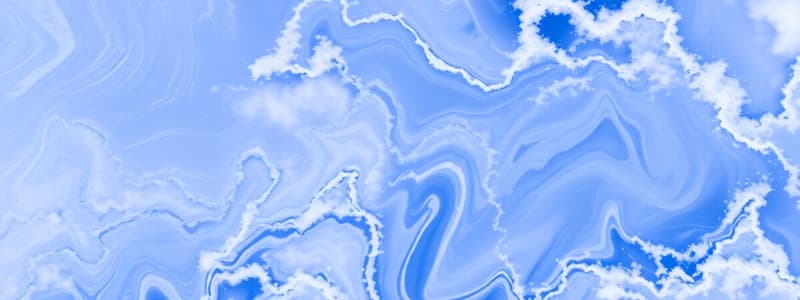Podcast
Questions and Answers
Which atmospheric layer is known for containing the ozone layer?
Which atmospheric layer is known for containing the ozone layer?
- Mesosphere
- Thermosphere
- Troposphere
- Stratosphere (correct)
What is the primary distinction between the study of meteorology and climatology?
What is the primary distinction between the study of meteorology and climatology?
- Climatology studies wind speeds, while meteorology measures solar radiation.
- Climatology is concerned with current weather events, whereas meteorology focuses on historical weather data.
- Meteorology deals with short-term atmospheric conditions, while climatology analyzes long-term weather patterns. (correct)
- Meteorology uses aggregated weather statistics, while climatology relies on real-time atmospheric measurements
In what layer of the atmosphere do most weather phenomena occur?
In what layer of the atmosphere do most weather phenomena occur?
- Troposphere (correct)
- Mesosphere
- Exosphere
- Thermosphere
Which of the following best describes the exosphere?
Which of the following best describes the exosphere?
Which of these is NOT a variable commonly measured for real-time weather analysis?
Which of these is NOT a variable commonly measured for real-time weather analysis?
What is the basic temporal period used to calculate "climate normals"?
What is the basic temporal period used to calculate "climate normals"?
What is the approximate composition percentage of oxygen in Earth's atmosphere?
What is the approximate composition percentage of oxygen in Earth's atmosphere?
Which type of precipitation forms when rain falls through a freezing temperature layer causing water droplets to turn into ice particles?
Which type of precipitation forms when rain falls through a freezing temperature layer causing water droplets to turn into ice particles?
What is the coldest layer of Earth's atmosphere?
What is the coldest layer of Earth's atmosphere?
Which of the following is a core element of weather as described in the context?
Which of the following is a core element of weather as described in the context?
Which layer of the atmosphere is characterized by very high temperatures, though it would not feel hot to a human?
Which layer of the atmosphere is characterized by very high temperatures, though it would not feel hot to a human?
If you were monitoring weather, which of these would be your main focus?
If you were monitoring weather, which of these would be your main focus?
What is the minimum diameter a water droplet must have to be classified as rain?
What is the minimum diameter a water droplet must have to be classified as rain?
Which of these best describes climatology?
Which of these best describes climatology?
What does the prefix 'Meso' in the term 'Mesosphere' refer to?
What does the prefix 'Meso' in the term 'Mesosphere' refer to?
Which of the following best describes freezing rain?
Which of the following best describes freezing rain?
What type of precipitation is characterized by round pellets of ice, larger than 5 millimeters in diameter?
What type of precipitation is characterized by round pellets of ice, larger than 5 millimeters in diameter?
What type of data would a meteorologist primarily use?
What type of data would a meteorologist primarily use?
Up to what approximate altitude above the Earth's surface does the troposphere extend?
Up to what approximate altitude above the Earth's surface does the troposphere extend?
Which of these cloud types is most likely to produce mist or drizzle?
Which of these cloud types is most likely to produce mist or drizzle?
Which choice provides the most useful information for generating a weather forecast?
Which choice provides the most useful information for generating a weather forecast?
What process forms hailstones within storm clouds?
What process forms hailstones within storm clouds?
Which of the following statements regarding precipitation is correct?
Which of the following statements regarding precipitation is correct?
What is the key difference that distinguishes sleet from freezing rain?
What is the key difference that distinguishes sleet from freezing rain?
What causes the sound of thunder?
What causes the sound of thunder?
Why should you avoid touching metal objects during a thunderstorm?
Why should you avoid touching metal objects during a thunderstorm?
If caught in an open area during a thunderstorm, what is the best action to take?
If caught in an open area during a thunderstorm, what is the best action to take?
What is the primary source of energy for hurricanes?
What is the primary source of energy for hurricanes?
What is the 'eye' of a hurricane?
What is the 'eye' of a hurricane?
Which climate zone is characterized by having the most moderate temperatures and rainfall year-round?
Which climate zone is characterized by having the most moderate temperatures and rainfall year-round?
What is the key characteristic of a tornado?
What is the key characteristic of a tornado?
What is the primary cause of all winds?
What is the primary cause of all winds?
What is a waterspout?
What is a waterspout?
Which instrument is used to measure wind direction?
Which instrument is used to measure wind direction?
What is the weather pattern that occurs when the eye of a hurricane reaches an area?
What is the weather pattern that occurs when the eye of a hurricane reaches an area?
If a wind is described as a 'west' wind, what is its direction of origin?
If a wind is described as a 'west' wind, what is its direction of origin?
What causes differences in air pressure that leads to unequal heating of the atmosphere?
What causes differences in air pressure that leads to unequal heating of the atmosphere?
What happens when air is heated by the Earth's surface?
What happens when air is heated by the Earth's surface?
When do local winds typically form?
When do local winds typically form?
Which of the following best defines climate?
Which of the following best defines climate?
How does an anemometer measure wind?
How does an anemometer measure wind?
What is the primary difference between weather and climate?
What is the primary difference between weather and climate?
What is one reason coastal areas are cooler in the summer compared to inland areas?
What is one reason coastal areas are cooler in the summer compared to inland areas?
What effect does distance from the sea have on climate?
What effect does distance from the sea have on climate?
What role does the ocean play in regulating the planet's climate?
What role does the ocean play in regulating the planet's climate?
Which of these is NOT a significant factor influencing Earth's climate patterns?
Which of these is NOT a significant factor influencing Earth's climate patterns?
Why does the central part of a continent typically experience a large range of temperatures?
Why does the central part of a continent typically experience a large range of temperatures?
How does the circulation of ocean water affect regional weather?
How does the circulation of ocean water affect regional weather?
Flashcards
Troposphere
Troposphere
The lowest layer of the atmosphere, extending from the Earth's surface to about 10 km.
Stratosphere
Stratosphere
The layer above the troposphere, extending from 10 km to 50 km. It contains the ozone layer.
Mesosphere
Mesosphere
The middle layer of the atmosphere, extending from 50 km to 80 km. It's the coldest layer.
Thermosphere
Thermosphere
Signup and view all the flashcards
Exosphere
Exosphere
Signup and view all the flashcards
Temperature
Temperature
Signup and view all the flashcards
Heat
Heat
Signup and view all the flashcards
Nitrogen
Nitrogen
Signup and view all the flashcards
Climatology
Climatology
Signup and view all the flashcards
Meteorology
Meteorology
Signup and view all the flashcards
Climate Normals
Climate Normals
Signup and view all the flashcards
Real-Time Weather Measurements
Real-Time Weather Measurements
Signup and view all the flashcards
Weather Forecasting
Weather Forecasting
Signup and view all the flashcards
Aggregating Weather Statistics
Aggregating Weather Statistics
Signup and view all the flashcards
Weather
Weather
Signup and view all the flashcards
Determining Weather Factors
Determining Weather Factors
Signup and view all the flashcards
Climate
Climate
Signup and view all the flashcards
Distance from the Sea
Distance from the Sea
Signup and view all the flashcards
Ocean Currents
Ocean Currents
Signup and view all the flashcards
Prevailing Winds
Prevailing Winds
Signup and view all the flashcards
Shape of the Land
Shape of the Land
Signup and view all the flashcards
El Niño
El Niño
Signup and view all the flashcards
Distance from the Equator
Distance from the Equator
Signup and view all the flashcards
What is wind?
What is wind?
Signup and view all the flashcards
What causes wind?
What causes wind?
Signup and view all the flashcards
How does unequal heating affect wind?
How does unequal heating affect wind?
Signup and view all the flashcards
How do we measure wind direction?
How do we measure wind direction?
Signup and view all the flashcards
How do we measure wind speed?
How do we measure wind speed?
Signup and view all the flashcards
What are local winds?
What are local winds?
Signup and view all the flashcards
What are global winds?
What are global winds?
Signup and view all the flashcards
What is the polar climate zone?
What is the polar climate zone?
Signup and view all the flashcards
What is precipitation?
What is precipitation?
Signup and view all the flashcards
Describe rain.
Describe rain.
Signup and view all the flashcards
What is sleet?
What is sleet?
Signup and view all the flashcards
What is freezing rain?
What is freezing rain?
Signup and view all the flashcards
What is hail?
What is hail?
Signup and view all the flashcards
What is snow?
What is snow?
Signup and view all the flashcards
What factors determine the type of precipitation?
What factors determine the type of precipitation?
Signup and view all the flashcards
What type of cloud produces hail?
What type of cloud produces hail?
Signup and view all the flashcards
What is thunder?
What is thunder?
Signup and view all the flashcards
What causes thunder?
What causes thunder?
Signup and view all the flashcards
What is a hurricane?
What is a hurricane?
Signup and view all the flashcards
What is the eye of a hurricane?
What is the eye of a hurricane?
Signup and view all the flashcards
What is a tornado?
What is a tornado?
Signup and view all the flashcards
What is a waterspout?
What is a waterspout?
Signup and view all the flashcards
What are cumulonimbus clouds?
What are cumulonimbus clouds?
Signup and view all the flashcards
What are safety precautions during a lightning storm?
What are safety precautions during a lightning storm?
Signup and view all the flashcards
Study Notes
Weather and Climate Overview
- This module is for 6th grade science.
- Weather and climate are different things.
- Weather is the current atmospheric conditions like temperature, rainfall, wind, and humidity.
- Climate usually refers to the "average" weather patterns in an area over many years (typically 30 years).
- An essential question to consider is how temperature and different heating of land and water affect weather and climate.
Essential Questions
- How does temperature affect weather?
- How do land and water differ in how they absorb and lose heat?
- How does unequal heating of land and water lead to global wind systems?
- What are the causes of weather events (tornadoes, hurricanes, thunderstorms)?
- How can you relate the amount of moisture evaporation from the ocean to weather patterns and events?
Key Terms
- Atmosphere: The mixture of gases that surround Earth.
- Air pressure: The weight of air pressing down on an area.
- Troposphere: The bottom layer of Earth's atmosphere; where most weather occurs.
- Stratosphere: The layer above the troposphere; where ozone is present.
- Mesosphere: The layer above the stratosphere, where meteors burn up.
- Thermosphere: The outer most layer of the atmosphere.
- Radiation: The transfer of energy by electromagnetic waves.
- Conduction: The transfer of thermal energy through the collision of particles.
- Convection: The transfer of thermal energy through the movement of liquids or gases.
- Global warming: The rise in Earth's average temperature since the late 1800s and its predicted continuation.
- Greenhouse effect: The process in which gases hold heat in the atmosphere.
- Temperature: The average amount of energy of motion in the molecules of a substance; a measure of how hot or cold something is.
- Global winds: Winds that continually blow over long distances from specific directions.
- Local Winds: Winds that blow over shorter distances.
- Coriolis effect: The way Earth's rotation makes winds in the Northern Hemisphere curve to the right and winds in the Southern Hemisphere curve to the left.
- Water cycle: The continuous movement of water from Earth's surface to the atmosphere and back again as water vapor, precipitation (rain/snow), and ultimately evaporation.
- Jet stream: A high speed, meandering air current.
- Humidity: The amount of water vapor in the air.
- Relative humidity: A comparison of the actual water vapor to the amount that could exist in the air at a given temperature and pressure.
- Evaporation: The process of water changing from a liquid to a gaseous state.
- Condensation: The process of water vapor changing from a gas to a liquid state.
- Cumulus: Fluffy, rounded clouds often associated with fair weather.
- Stratus: Flat, layered clouds.
- Cirrus: Wispy, feathery clouds high in the atmosphere.
- Barometer: An instrument used to measure air pressure.
- Meteorologist: A scientist who studies the atmosphere and weather.
- Precipitation: Any form of water that falls from the atmosphere to Earth's surface (e.g., rain, snow, sleet, hail).
- Air mass: A large body of air with relatively uniform temperature and humidity properties.
- Front: The boundary between two air masses with different characteristics.
- Climate: The average, long-term weather conditions of a region.
- Tornadoes: Rapidly swirling, violently rotating columns of air.
- Hurricanes: Large, swirling tropical storms.
- Heat: The transfer of thermal energy.
Atmospheric Layers and Heights
- Troposphere: 0 - 18 km, bottom layer
- Stratosphere: 18 – 50 km, contains ozone layer
- Mesosphere: 50 - 80 km, meteors burn here
- Thermosphere: 80 - 690+ km, Aurora Borealis occurs here.
- Exosphere: 690+ km, outside layers of atmosphere
Studying That Suits You
Use AI to generate personalized quizzes and flashcards to suit your learning preferences.
Related Documents
Description
Explore the differences between weather and climate in this 6th-grade science quiz. Understand how temperature, land, and water heating affect atmospheric conditions and global wind systems. Test your knowledge on various weather events and their causes.




